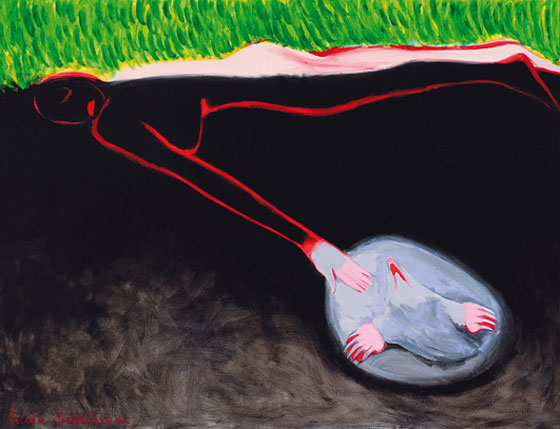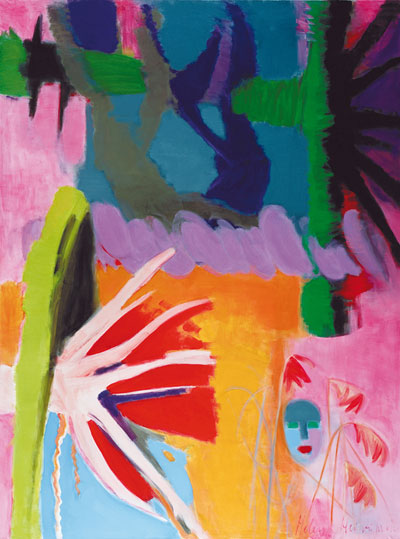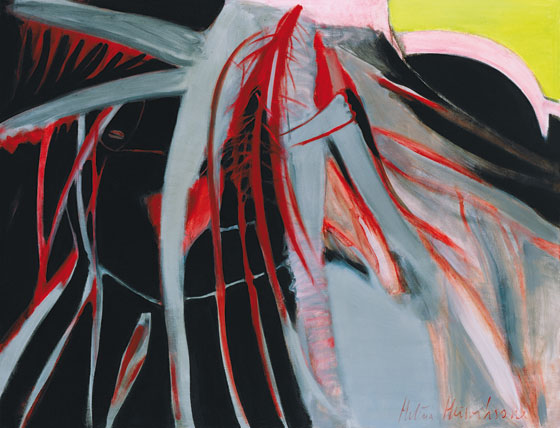|
|
| Picturesque greetings to a mole Dace Lamberga Helēna Heinrihsone - an elegant woman of indiscernible age always dressed in black; a young-in-spirit, free-thinking personality; one of the stars of contemporary Latvian painting. | |
 Helēna Heinrihsone. Greetings, Mole"!. 2007 | |
| Her name, valued so highly by professionals, has been written into art history letter-by-letter for over thirty years. I think I noticed Heinrihsone's laconic, colourful and stylistically convincing work for the first time in 1978 in a young artists' painting exhibition in St Peter's Church. I knew that up until then the creative path of the emerging artist had been strewn with thorns rather than roses: for a number of years in a row, her characteristically individualist contributions to exhibitions were rejected again and again. This was not due to unprofessionalism, but because of the unexplainable fear of purposeful innovation held by the officials of the stagnation era. Heinrihsone managed to keep her chin up and did not begin to desperately clutch at straws - at popularly commissioned themes, such as seamstresses, builders or the communist youth, commonly varied by her contemporaries. During that depressing situation, encouragement was provided by the attention of painter and theoretician Ojārs Ābols, which was followed by her first commission from the Art Foundation. Nevertheless, when preparing the exhibition "Echoes of Fauvism. Latvian Painting: 1910-1980", I discovered with true amazement, that the Latvian National Museum of Art did not possess any of Heinrihsone's works from the 1970s. The absence was quickly corrected with the acquisition of the much-published composition, "The Conversation" (1978); but the reminder nevertheless remains, that the avantgarde approach of Helēna Heinrihsone, which had already claimed a lasting place in Latvian painting, was routinely ignored by the acquisitions committee of the Ministry of Culture of the time. What this attitude meant at that time to the emerging artist is known only by herself and those close to her, but luckily the long-term official silence did not influence her creative spirit. The tense internal struggle for the acknowledgement of her achievement perhaps created even more obstinacy and determination, of which the result was Helēna Heinrihsone's first personal exhibition in December 1990 at the State Museum of Art. This was not even a simple solo exhibition; artistic life changed as a result of political change, and Heinrihsone was the first of her generation and the youngest overall - not to mention lacking titles such as "Artist of the People" or even "Richly Rewarded" - to be exhibited in the prestigious White Hall. At that time she gave an emotional answer to my question of what it meant to her to have an exhibition in the museum: that a painter can only dream of having access to the kind of light and cultural milieu which makes each work more noble. The time was overflowing with big and seemingly utopian hopes; the Berlin wall had fallen, and Latvian art had begun, although fearfully, but step by step to ‘conquer' Western Europe and America. However, this was also full of unknown changes, political economic clashes and commotion. The first articles about Heinrihsone's exhibition had already appeared in the papers when the dramatic events of the January barricades occurred and these were followed by a press blockade. Helēna Heinrihsone's first solo exhibition challenged the viewers, immersed in their own routine, with its unusual improvisations: from the abundant mannered images of Meissen porcelain to a woman-Christ covered in scars, which in her mind symbolised the terrible situation for women in the state at that time. Explaining her painting to a foreigner, Heinrihsone described it in English as having ‘dangerous beauty'. Her contemporary style, which spoke ironically of the danger of outer beauty, was fascinating with its sharp world view, laconic language of forms and use of colour. Viewing Heinrihsone's triptych altarpiece, "The Hands of St Peter", "The Crucified" and "The New City" (1993) at the architecturally unpretentious, freshly restored Evangelical Lutheran Church at Kolka, gave me a totally opposite, unexpected emotional surprise. The dominant fields of local colours - in red, blue, yellow and white - and the gold accents important to sacral painting since Byzantine times, gave a quiet, harmonious impression. The neat ascetic interpretation of a religious theme and optimism of the light colour scheme allowed, without any kind of iconographic attributes, to feel the message about the expected miracle of resurrection. The solo exhibition "Greetings, Mole!" (13 July-12 August 2007) at the Latvian National Museum of Art reveals a well-known, but at the same time totally different insight into the painting of Helēna Heinrihsone, in which the logical and realistic world view has been recreated into the conditionality of unusual form and a more expressively saturated colourfulness than earlier. The title of the exhibition has been derived from a composition of the same title which reveals a figure, closely crouching pressed against the earth, even merging into it, and a mole in its dark depths. A sense of tiredness and sorrow is expressed toward the human image, while the unpredictable digger, the mole, associates with commotion and activity. Similarly in all of Heinrihsone's painting, the dramatic nature of experience competes with the active vitality of her personality as the dominant feature. This has been inspired both by the themes of carnival from the canvases of Goya and Bosch at the Madrid Prado and the temperamental layers of Mexican culture, as well as our own Latvian nature: dried, tonally rich tree leaves and vibrating reflections in water. | |
 Helēna Heinrihsone. Brawl in the Swamp. 2007 | |
|
Heinrihsone tells of the inspirational swamp which divides her house at Saunags from the sea, and she demonstrates the source of inspiration - photographs with aestheticized beautiful fragments of real nature, with naked trees and roots ripped out by the wind in a flooded marsh. As distinct from the noble and powerful forest, the swamp has always possessed something mysteriously enticing, frightening and mystical in the consciousness of humans; in Heinrihsone's paintings from 2007 ("Battle with Roots"; "Brawl in the Swamp") these real ‘earthy' feelings have been transformed into expressive conditionality. Purple, green, yellow and pink fields of colour with pictorially soft transitions are arranged in unusually saturated density. The concentration of colours and feelings calls to memory such outstanding examples of painting as Edgars Iltners' dramatic landscapes of the Kurzeme coastline and the stimulating form of expression of the neoexpressionist Rainer Fetting of the German Neue Wilde group. In turn, the laconically stylised group of skulls, "The Blue One", "The Orange One", "The Green One", "The Red One" and "The Purple One" in the first instance creates associations with Andy Warhol's eternally circulated, colourful Marilyn series, although the comparison ends there. Warhol, no matter how brilliant, reproduced one and the same image, while Heinrihsone's compositions of colour fascinate one precisely with their rich pictorial depth. Skulls arouse dislike in people - they are associated with death, although their form is just as ideally proportional as everything created in nature. The classic vanitas theme about the futility of life in the face of eternity has been painted by so many classic painters, but Heinrihsone's skulls and bones prosaically associate with her memories of childhood - her mother studied medicine and she and her sister used to play with the educational aids. When her early experience was layered with fascinating experience in the Mexican Anthropology Museum, these mystical, ghostly skulls were created. Leo Svemps once expressed the idea that he who can paint roses is a real painter. No wonder amateurs are those who have most often tried to immortalize this queen of the flowers, because they do not fear to transform this seductive beauty into a benchmark of kitsch. Helēna Heinrihsone is one of the rare contemporary painters who paints roses. She also photographs them, which was demonstrated in the attractive exhibition "Nature's Photographers" (2003). This summer a whole wall in a Rundāle Castle exhibition "A Rose... What is a Rose?" has been dedicated to Heinrihsone's work. Painted ‘portraits' of roses, a series of photographs and an installation with skulls and wilted flowers are exhibited in Imants Lancmanis' popular, crowded ‘castle style' arrangement. Her solo exhibition includes large format canvases with roses, which the artist believes are an "indiscernible boundary between beauty and exaggeration". Heinrihsone paints wilted roses, the symbol of romanticism and eternity; in actual fact in these images of flowers it is precisely the diversity of nature which has given her the inspiration for the fine composition of colours, brush strokes and spatial unity. "Two" (2007) - slender, long stems with wilted flowers - calls forth associations with completely humane, strangely sorrowful feelings. Although the first example is realistic - the rose ‘models' are still able to be seen in the artist's studio, the composition has been reduced to be harshly minimal, sometimes even nearing abstraction. However, the spiritual and physical energy invested into the painting process tries to break out, subjecting the viewer to unexpected emotions. Roses and skulls are two extremes in the consciousness of people - noble beauty and frightening death - although Heinrihsone's paintings turn this cliched assumption on its head. Innovative art has always provocatively crossed the most widely accepted assumptions: the roses with broken, bent heads express a feeling of a minor key, while the skulls are fascinating with their stimulating colour saturation. In her solo exhibition in 1990 Heinrihsone's canvases were dominated by playful flirtation with the pretentious manners of Meissen porcelain, which were challenging with their puckish self-assuredness. Now this figurative fragility and external beauty, although also dangerous, no longer engage the artist, and she chooses diametrically opposite shapes for her compositions - massive, robust men's bodies. These torsos have corners, often without heads, and embody primal strength and brutality: their heads are needed neither as spiritual values, nor for shape. Horizontal canvases placed one above the other as a diptych "Narcissus" and "Garden" (both from 2007) with red linear reclining figures and an exceptionally large arrangement of roses, seem to reflect masculine strength, but at the same time communicate passive self satisfaction, and the feminine wish to be the first and the most beautiful. Fauvism is long gone, but its call for a heightened attitude to colour remains. In the 1970s Heinrihsone supplemented the power of local fields with white contrasts, creating an optimistic feel; in time her colour relationships gained a more emotional diversity. In recent years, the colourfulness of her painting has gained an unusually rich depth. The artist's brush works on the surface of the canvas protractedly, layering at least ten, but often more glazing layers of colour, in a style similar to the old masters. Glazing has turned out to be a truly intensive process, but luckily, a binding agent has been invented which allows the colour to dry more quickly, so that the next layer can be applied the following morning. Some works are painted over a series of months, because Heinrihsone enjoys the process of creation itself. Painting is not just a moment of all-encompassing inspiration and spiritual baggage which has been collected from reproductions and museums around the world, but also a completely everyday thing like technology. Helēna uses only oil paint, under no circumstances does she use acrylic, with which you must work quickly. Oil paint, on the other hand, allows you to scrape off parts and re-paint sections. Although the paintings have been created through a long process, you do not sense the amount of work invested - this should not be allowed to be sensed by any means. Jānis Liepiņš, for example, admitted that no matter how long a canvas has been worked on, you have to feel the freshness of the first sketch. This idea is supported by the concentration of Heinrihsone's impressions of a trip to Paris "A Picnic in the Boulogne Forest" (2007). The artist's elusively constructed compositions cannot be perceived as telling a tale, however there is a real experience at the basis of each of the works. This scene has been inspired by a picnic organised in the Boulogne forest, similar to a picnic of the French Impressionists in the late 19th century: dusk has begun to fall, neon signs are beginning to shine and the fascinating magic of the night face of a romantic city are revealed. I would like to single out the canvas "A Picnic in the Boulogne Forest" as a symbol, which illustrates the time between Helēna Heinrihsone's first and second solo exhibitions, full of turns and radical changes. This is not only some seventeen unbroken years of creative work, but it also represents opportunities which have been gained as the "iron curtain" fell, so important and invaluable for a creative personality: opportunities to look at and study the world, people, museums and discoveries of her contemporaries. | |
 Helēna Heinrihsone. Battle with Roots. 2007 | |
| go back | |







